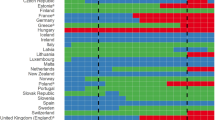Abstract
The controlling of outpatient drug costs in Germany is implemented almost entirely on the federal state level. Each year the regional representatives of the Statutory Health Insurances (SHI) and the Association of SHI Physicians in all federal states have to define an upper limit for pharmaceutical expenditures. In the most northern federal state (Schleswig-Holstein) the regional parties agreed on a morbidity related approach solely based on prescription data to meet with the spending target. The underlying patient-related classification system is called Morbidity Related Groups (MRG). Introductory the underlying data, the present model for controlling measures and the hard-/software used today will be discussed. Subsequently improvements and extensions to the MRG classification system leading to a generalized model of drug resourcing are suggested.



Similar content being viewed by others
Notes
With minor changes all equations in this paper originate from [6].
References
Analyzing controlling pharmaceutical expenditures. 2012. Managing access to medicines and health technologies, Chapter 40 p 33.
Bratzke B, Spies K-P, Krebs S. 2012. Morbiditätskomponente bei Arznei- und Heilmittelbudgets einführen. Deutscher Ärztetag Drucksache V I-37.
Breyer F, Ulrich F. Gesundheitsausgaben, Alter und medizinischer Fortschritt: Eine Regressionsanalyse. Jahrbü,cher für Nationalökonomie und Statistik 2000;220:1–17.
Busse R, Panteli D, Krebs S. 2015. Arzneimittelversorgung in der GKV und 15 anderen europäischen Gesundheitssystemen: Ein systematischer Vergleich. Working papers in health policy and management Universitä,tsverlag der TU Berlin p 11.
Dranove D, Ody C, Starc A. A dose of managed care: Controlling drug spending in medicaid NBER Working Paper No 23956. Cambridge: National Bureau of Economic Research; 2017.
Emcke T, Ostermann T, Heidbreder M, Schuster R. 2017. Comparison of different implementations of a process limiting pharmaceutical expenditures required by german law. Healthinf 2017.
GKV Versorgungsstärkungsgesetz (GKV-VSG) BGBl I: 1211, 2015.
Gottwald N. 2015. Damoklesschwert richtgrößenprüfung. Im Dschungel der 25-Prozent-Regel. HNO-Nachrichten Springer p 3.
Korzilius N. 2015. Arzneimittelrichtgrößen: Ärzte sollen angstfrei verordnen. Dtsch Arztebl p 112.
Kreling D. 2000. Cost control for prescription drug programs: Pharmacy benefit manager - efforts, effects and implications Backround report prepared for the Department of Health and Human Services - Conference on Pharmaceutical Pricing Practices, Utilization and Costs, Georgetown University Washington.
Schuster R. 2015. Morbidity Related Groups (MRG) and drug economic index - a new concept after the age of richtgrößen benchmarks in Germany. GAA 2015.
Schuster R, von Arnstedt E. 2012. Medizinischer-technischer Fortschritt und demografischer Wandel bei den GKV-Ausgaben im vertragärztlichen Bereich. GMDS 2011.
Schuster R, Voss H. 2012. Medizinischer-technischer Fortschritt und demografischer Wandel bei den GKV-Ausgaben im DRG-Bereich im Krankenhaus. GMDS 2012.
Sinowatz F. 2015. Ressourcenalokation in der hausärztlichen Versorgung: eine empirische Untersuchung. Dissertation LMU München: Medizinische Fakultät.
Wersborg T. 2006. Morbiditätsbezogene richtgrößen zur Steuerung einer bedarfsgerechten und wirtschaftlichen Arzneimittelversorgung innerhalb der gesetzlichen Krankenversicherung in Deutschland. Dissertation LMU München: Medizinische Fakultät.
Funding
There is no funding source.
Author information
Authors and Affiliations
Corresponding author
Ethics declarations
Conflict of interests
All four authors declare that they have no conflict of interest.
Ethical Approval
This article does not contain any studies with human participants or animals performed by any of the authors.
Informed Consent
Not applicable.
Rights and permissions
About this article
Cite this article
Emcke, T., Ostermann, T., Heidbreder, M. et al. Morbidity related controlling of pharmaceutical expenditures using prescription data. Health Technol. 8, 353–359 (2018). https://doi.org/10.1007/s12553-018-0262-2
Received:
Accepted:
Published:
Issue Date:
DOI: https://doi.org/10.1007/s12553-018-0262-2




